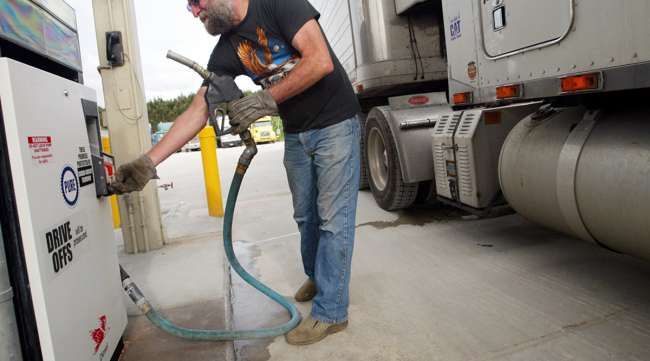Senior Reporter
Diesel Falls 1.7¢ to $2.994 in Sixth Consecutive Decline

[Stay on top of transportation news: Get TTNews in your inbox.]
The U.S. average retail price of diesel dropped 1.7 cents to $2.994 a gallon, the Department of Energy reported Aug. 19. Crude oil prices lifted moderately to pass $56 a barrel as U.S.-China trade tensions eased somewhat, while a drone attack on an oil field in Saudi Arabia rekindled concerns over the oil supply chain.
The price of diesel has fallen for six consecutive weeks since July 15, when the price was $3.051 per gallon, and it marked the first time diesel fell below $3 since Feb. 11, when it was $2.966.
Trucking’s main fuel costs 21.3 cents less than it did a year ago, when it was $3.207, DOE said.
Also, the national average price for regular gasoline dropped 2.6 cents to $2.598 a gallon, DOE’s Energy Information Administration said.

In our first episode of RoadSigns, Season Three, we ask: How Can Trucking Take Fuel Economy to the Next Level? Hear a snippet from host Seth Clevenger, above, and get the full program by going to RoadSigns.TTNews.com.
All regions saw average prices decline. The Gulf Coast posted the largest decline at 5.5 cents and fell to $2.269 a gallon.
Meanwhile, Volvo Trucks North America announced the next generation of its turbo compound technology, providing up to an additional 3% improvement in fuel efficiency over the current 13-liter turbo compound engine, the D13TC. Other improvements include enhanced efficiency over a wider range of applications, more engine ratings and a new EE (extra efficiency) drive mode.
The new D13TC engine delivers up to an 11% fuel savings overall compared with model-year 2015 trucks. It will be available for order in the fourth quarter and go into production at the end of the first quarter of 2020, according to the Greensboro, N.C.-based company, a unit of Volvo Group.
The new engine offers dynamic torque, an additional 405 horsepower rating and the next evolution of its patented wave piston design.
Dynamic torque — rather than operating in silos of high-torque and low-torque modes — automatically sets a torque level dependent upon the weight of the truck, the grade and the road conditions at any given time.
The improved piston evenly distributes the air-fuel mixture in the cylinder, burning the fuel more consistently than a traditional piston. Volvo’s design increases the compression ratio to 18:1 from 17:1 while maintaining up to a 90% reduction of soot in the cylinder, further improving fuel efficiency in the engine.
VTNA estimated the new engine, compared with the current D13TC engine, could save about $1,200 per year per truck, based on the average fuel price and 125,000 miles per year.
The first generation of the D13TC engine was designed specifically for over-the-road, longhaul applications for trucks loaded at 80,000 pounds.
At the same time, for Cumberland International in Nashville, Tenn., boosting the fuel efficiency of its C10 trucks has meant using a full factory-installed aero trim package, 6×2 drive axles, wide-base single tires, auxiliary power units and more driver training. And now TruckWings, which automatically deploys panels from the back of the cab to cover the tractor-trailer gap when a truck is at highway speeds.
Cumberland started spec’ing Class 8 Internationals for optimum fuel efficiency in 2013 and called the truck the C10 — after the dealership and the goal of attaining 10 mpg, which it has since achieved.
Cumberland and its C10 Project won the 2019 Tennessee Governor’s Environmental Stewardship Award in the clean air category, presented by Gov. Bill Lee.
We won the TN Governor's Environmental Stewardship Award for the C10 truck. The ceremony was today and we were honored to be among the many impressive recipients. #stewardship #2019GESA @GovBillLee @Mendy87 pic.twitter.com/xGhHzrM8ar — Cumberland International Trucks (@CumberlandTruck) August 1, 2019
“An honor like this helps improve the industry’s image and reputation” as putting out emissions that foul the air, Patrick Mendenhall, Cumberland fleet sales manager, told Transport Topics.
Early in the week, the Trump administration signaled progress on trade negotiations as the U.S. delayed sanctions against Huawei Technologies Co., on which it has gone tougher, then softer over the months.
“It’s kind of like a drunken walk,” Paul Nolte, a money manager at Kingsview Asset Management in Chicago, told Bloomberg News. “There’s no rhyme or reason from day to day as to what’s happening with trade, and trade is really what’s driving the markets. And there’s no way to handicap it. There is no glide path, there is no, ‘Here’s what happening.’ It’s a random walk.”
West Texas Intermediate crude futures on the New York Mercantile Exchange closed at $56.21 on Aug. 19 compared with $54.93 per barrel Aug. 12.
U.S. commercial crude oil inventories (excluding those in the Strategic Petroleum Reserve) decreased by 2.7 million barrels from the previous week. At 437.8 million barrels, U.S. crude oil inventories are about 2% above the five-year average for this time of year, EIA reported.




